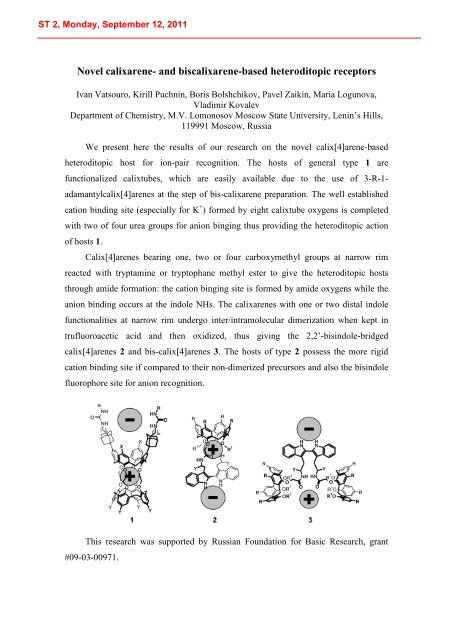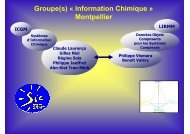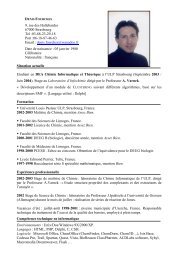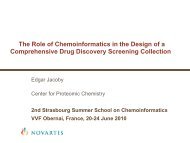International Summer School PROGRAM - Laboratoire d'Infochimie ...
International Summer School PROGRAM - Laboratoire d'Infochimie ...
International Summer School PROGRAM - Laboratoire d'Infochimie ...
You also want an ePaper? Increase the reach of your titles
YUMPU automatically turns print PDFs into web optimized ePapers that Google loves.
Novel calixarene- and biscalixarene-based heteroditopic receptors<br />
Ivan Vatsouro, Kirill Puchnin, Boris Bolshchikov, Pavel Zaikin, Maria Logunova,<br />
Vladimir Kovalev<br />
Department of Chemistry, M.V. Lomonosov Moscow State University, Lenin’s Hills,<br />
119991 Moscow, Russia<br />
We present here the results of our research on the novel calix[4]arene-based<br />
heteroditopic host for ion-pair recognition. The hosts of general type 1 are<br />
functionalized calixtubes, which are easily available due to the use of 3-R-1-<br />
adamantylcalix[4]arenes at the step of bis-calixarene preparation. The well established<br />
cation binding site (especially for K +<br />
) formed by eight calixtube oxygens is completed<br />
with two of four urea groups for anion binging thus providing the heteroditopic action<br />
of hosts 1.<br />
Calix[4]arenes bearing one, two or four carboxymethyl groups at narrow rim<br />
reacted with tryptamine or tryptophane methyl ester to give the heteroditopic hosts<br />
through amide formation: the cation binging site is formed by amide oxygens while the<br />
anion binding occurs at the indole NHs. The calixarenes with one or two distal indole<br />
functionalities at narrow rim undergo inter/intramolecular dimerization when kept in<br />
trufluoroacetic acid and then oxidized, thus giving the 2,2’-bisindole-bridged<br />
calix[4]arenes 2 and bis-calix[4]arenes 3. The hosts of type 2 possess the more rigid<br />
cation binding site if compared to their non-dimerized precursors and also the bisindole<br />
fluorophore site for anion recognition.<br />
This research was supported by Russian Foundation for Basic Research, grant<br />
#09-03-00971.









